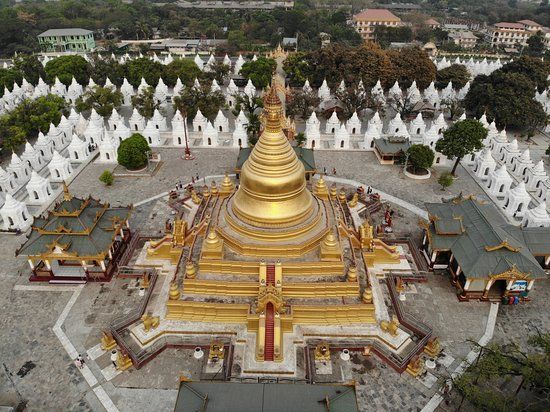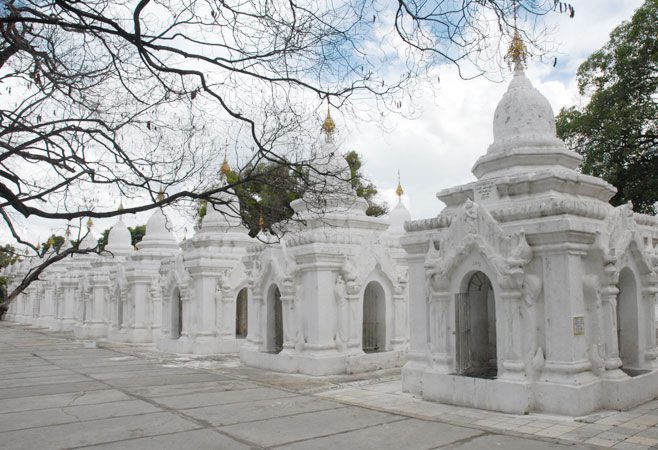Kuthodaw Pagoda – 729 Inscribed marble slabs
Kuthodaw pagoda is a Buddhist stupa, located in Mandalay, Myanmar. Kuthodaw Pagoda is a fascinating Buddhist religious site built at the base of Mandalay Hill that was looted by the British Army at the end of the 19th century and then restored by donations from all over Myanmar.

Overview of Kuthodaw Pagoda
1. 729 Inscribed marble slabs in Kuthodaw Pagoda, known as “the world’s largest book”
The Kuthodaw pagoda in Mandalay comprises of a gilded pagoda, hundreds of shrines housing inscribed marble slabs and several pavilions. The Kuthodaw pagoda is also called “the world’s largest book”, named after the 729 marble slabs inscribed with Buddhist teachings.

The inscribed marble slabs in Kuthodaw Pagoda
In Burmese known as the Maha Lawka Marazein Paya, the Kuthodaw is located at the foot of Mandalay Hill. The large grounds offer good views upwards of Mandalay Hill with its many temples and pagodas. King Mindon ordered the “book” to be made. The works started in 1860 and took 8 years to complete. The texts were copied from ancient manuscripts written on dried palm leaf, the letters chiselled out of the stone and inlaid with gold leaf. Each marble slab measuring 153 centimeters tall and 107 centimeters wide is enshrined in a structure called Dhamma ceti or kyauksa gu in Burmese, “gu” meaning cave.
2. Construction of Kuthodaw Pagoda
The construction of the Kuthodaw Pagoda began in 1860 as a royal project, coinciding with Mandalay’s designation as the new capital. Construction lasted eight years. The 57-metre-high gilded stupa in the center took two years to complete. What took a long time was the completion of the 729 scripture halls located inside the temple complex. Each of these smaller structures contains a marble tablet inscribed on both sides with parts of the Tripitaka, which are the Buddhist holy scriptures. The temple is sometimes referred to as the ‘World’s Largest Book’ in reference to these 729 tablets, each of which is 153 cm tall and 107 cm wide.

Kuthodaw Pagoda in Mandalay
Kuthodaw Pagoda was originally a gold and jewel-encrusted structure. Each scripture hall was topped by an hti, a traditional umbrella-shaped ornament made of gold and encrusted with precious stones, and the inscriptions on the tablets were gold leaf painted. When the British Army took control of Mandalay in 1885, troops were billeted in the city’s temples and palaces, including the Kuthodaw Pagoda. When they finally left Kuthodaw Pagoda in 1890, the temple had been stripped of all its gold and jewels, as well as carved wooden panels and numerous statues. Everything valuable that could be easily carried out was left with the troops. The temple was eventually restored with donations from Burmese people, including the Royal Family, but with less expensive materials. The inscriptions on the stone tablets have been black inked.

Golden pagoda in the center of Kuthodaw Pagoda
3. Desecration and restoration
When the British army seized Mandalay in 1885 the grounds of the Kuthodaw pagoda were used as a garrison. The British vandalized the Kuthodaw complex, stole the gold, jewels and other gems from the hti of the pagoda and removed the gold from the letters on the slabs.
After the British had left restoration works started mostly funded by donations from Burmese people. The Kuthodaw pagoda was regilded, the letters on the marble slabs redone in black ink instead of gold. It took several decades until the works were completed and the Kuthodaw pagoda was restored to its former glory.

The monks in Kuthodaw Pagoda
4. How to get to the Kuthodaw pagoda
The Kuthodaw pagoda is located just East of the Mandalay Royal Palace in the North part of Mandalay, very near the Sandamuni pagoda, Atumashi monastery and Shwenandaw Monastery. You can use public transportation to get there. Otherwise, taxi is also a good choice that many tourists choose.
5. Opening hours
The Kuthodaw pagoda opens daily from 8 am until 8 pm.
6. Entrance fee
Entrance fee is about US$ 5 per person


